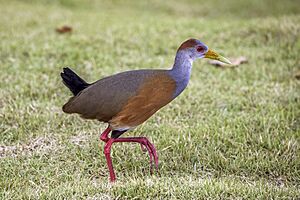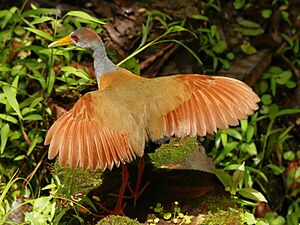Russet-naped wood rail facts for kids
Quick facts for kids Russet-naped wood rail |
|
|---|---|
 |
|
| Conservation status | |
| Scientific classification | |
| Genus: |
Aramides
|
| Species: |
albiventris
|
| Subspecies | |
|
See text |
|
 |
|
| Synonyms | |
|
|
The russet-naped wood rail (Aramides albiventris) is a type of bird. It belongs to the rail, crake, and coot family, called Rallidae. You can find this bird from Mexico all the way to Costa Rica.
Contents
What's in a Name?
The russet-naped wood rail was first thought to be its own unique species. But in the early 1900s, scientists changed their minds. They decided it was a subspecies of another bird, the gray-necked wood rail.
However, in 2015, new research suggested it should be its own species again. So, in 2016, it was officially recognized as a separate species. The other bird, A. cajanea, was then renamed the grey-cowled wood rail.
Some groups, like the Clements taxonomy and BirdLife International, believe there is only one type of russet-naped wood rail. This is called being monotypic (meaning "one type"). But the International Ornithological Committee (IOC) lists five different subspecies:
- A. a. mexicanus
- A. a. vanrossemi
- A. a. albiventris
- A. a. pacificus
- A. a. plumbeicollis
What Does It Look Like?
The russet-naped wood rail is about 33 to 40 cm (13 to 16 in) long. That's about the size of a small chicken. It weighs around 450 to 600 g (16 to 21 oz). Male and female birds look very similar. Even the different subspecies are hard to tell apart.
Adult birds have a thick, dark yellow beak with a light green tip. Their eyes are a deep red color, and their legs and feet are red or pink. The top of their head and back of their neck are slate gray. They have a chestnut (reddish-brown) patch on the back of their head. Their back is grayish-olive, and their tail is black.
Their chin and upper throat are white. The sides of their neck, lower throat, and upper chest are gray. The rest of their chest and upper belly are a pale cinnamon color. This blends into a pale band, which separates it from their black lower belly and under-tail feathers. Young birds (juveniles) do not have white on their belly. Instead, their underparts are dark gray with some tawny (light brown) spots.
Where Does It Live?
The different types of russet-naped wood rails live in specific areas:
- A. a. mexicanus: Found in eastern Mexico, from southern Tamaulipas down to the Yucatán Peninsula.
- A. a. vanrossemi: Lives along the Pacific coast, from Oaxaca in southern Mexico to southern Guatemala and El Salvador.
- A. a. albiventris: Found from the Yucatán Peninsula through Belize into northern Guatemala.
- A. a. pacificus: Lives on the Caribbean coast of Honduras and Nicaragua.
- A. a. plumbeicollis: Found in northeastern Costa Rica.
This bird lives in many different places, both wet and dry. It likes fresh and saltwater marshes, swampy forests, and areas along rivers and streams. It also lives in thorn forests, semi-evergreen forests, and mangrove forests. The most important thing is that these places have lots of thick plants for cover.
Behavior
Staying Put
The russet-naped wood rail stays in the same area all year long. It does not migrate.
What Does It Eat?
This bird is usually shy and likes to find food hidden in thick plants. Sometimes, it will feed out in the open, especially along riverbanks. It has also been seen eating in grassy areas near forests. We don't know all the details of its diet. But we know it eats plants, snails, crabs, and even small snakes.
Reproduction and Nests
We don't know much about when the russet-naped wood rail nests. However, adults ready to breed have been seen in January, from April to June, and in August.
Their nest is like a shallow bowl. It's loosely made from sticks and plant fibers. They usually place the nest a few meters (several feet) up in a bush, vines, or a tree. Often, the nest is built over water. A female bird usually lays three to seven eggs. We don't know how long the eggs take to hatch or how long the young birds stay with their parents.
What Sounds Does It Make?
The song of the russet-naped wood rail is quite unique. People describe it as "a varied, rapid, crazed-sounding, rollicking, popping, and clucking series." Some examples of its calls sound like:
- "coo-coocoo-coo' ki-ki-kik' cococo"
- "pop-tiyi pop-tiyi co-co-co-co-co"
- "kook-kook-kook-kway!-kway!-kway!-kway!"
When it feels bothered, it might make a sharp shriek, a harsh cackle, or a growl. It also makes low grunting sounds like "puk", "whut", or "kuk". This bird is most vocal (makes the most noise) during twilight (dawn and dusk) and at night.
Is It Safe?
The IUCN (International Union for Conservation of Nature) has looked at the russet-naped wood rail. They have decided it is a species of "Least Concern." This means it is not currently in danger of disappearing. It lives in a very large area. Scientists estimate there are at least 50,000 adult birds. However, this number is thought to be going down.
No major threats have been found right now. But the places where this bird likes to live, like mangrove and marsh habitats, are very delicate. These types of habitats are some of the most threatened in the world.



